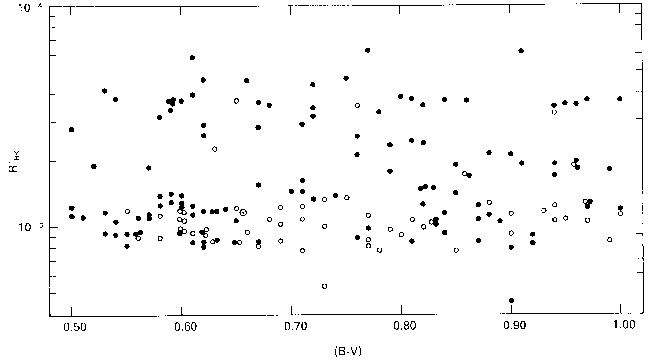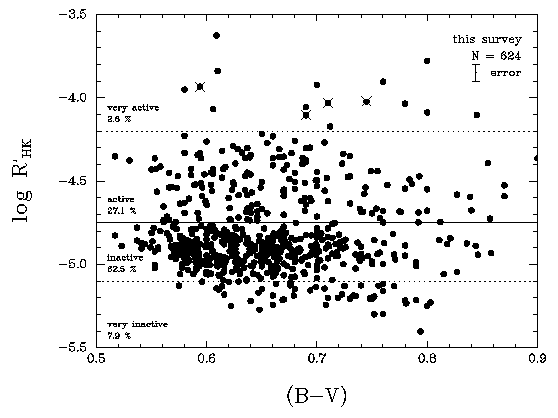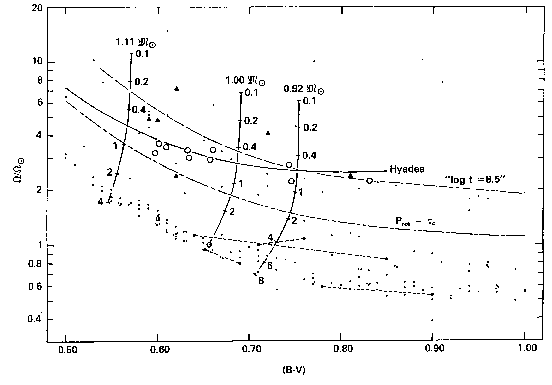
Composition: What we call Population I falls within about 50% of the solar [Fe/H], roughly, as inferred from iron-peak element lines in optical spectra. Other critical elements that affect a star's evolution (especially helium) cannot be measured directly in solar-type stars, but inferences can be made (see the paper by Cayrel de Strobel, this volume). Seen close-up, the detailed abundances in Solar System material, and the history of the enrichment of that material are surely unique because they are so complex. Asteroseismology may eventually probe significant differences by letting us see inside stars.
Question: Is the Sun's composition uniform throughout?Age: The Galactic disk is ~10 Gyr old, so the Sun at 4.5 Gyr is near the average age. Due to "disk heating'' (the increase of space velocity with age), the median age of disk is ~3 Gyr, so the Sun is a little on the old side, but not by much.
Axiom: If a star is not a known binary, it is probably because not enough effort has yet been put into detecting its companion or companions.Kinematics: The velocity of the Sun relative to the Local Standard of Rest is relatively low for its age. The same is true, curiously, for our nearest neighbor, the alpha Centauri system. This is an example of the flaws inherent in statistical statements.
Photometry: We know that sunspots can affect the light of the Sun by ~0.25% (Hudson 1988), which may be marginally measurable for stars. This translates to Delta Teff = 4 K, which may also be measurable (see below).

FIGURE 1:The Mount Wilson survey of Ca II H and K emission for solar type stars (see Vaughan & Preston 1980). The survey was done for northern, single, main sequence stars within 25 pc. The R'HK index is described in Soderblom (1985), from which this illustration is taken. The open circles are kinematically old stars.
The "gap'' down the center of the distribution could have one of two obvious explanations: 1. The activity-age relation has a bend so that intermediate-activity stars are rare. 2. The Galactic star formation rate has been uneven, so that intermediate-age stars are rare.
Henry et al. (1995), using a much larger sample (Figure 2), confirm the gap in a survey of HK emission in southern solar-type stars. Sterzik & Schmitt (1997) have just published results from a Rosat survey of 802 stars within 25 pc that also shows a gap. The x-rays should be immune to corrections for background light, continuum flux, etc.

FIGURE 2:Another survey of HK emission in solar-type stars, this time for southern stars within about 50 pc (Henry et al. 1995).
Rotation: Figure 3 shows the same diagram as above, but in units of rotation, transformed using a mean relation from stars of known rotation period (Noyes et al. 1984). This is not independent information, but, as far as we can tell, the Sun's rotation is typical for its type. Also, the broad trends here are real:

FIGURE 3:The Mount Wilson survey of Figure 1 transformed to units of rotation using a calibration from Noyes et al. (1984). The details of the transformation are described in Soderblom (1985). Three mass tracks are shown, as is a mean relation for the Hyades (whose stars are the open circles) and an estimate of a line for log t = 8.5 on the assumption that Skumanich's (1972) t-1/2 law holds for the decay of rotation with time.
The direct measurement of rotation of old solar-type stars is difficult, as either v\sin i or rotation period. This is because rotation is only a slight contributor to line breadth and because the low activity of older solar-type stars reduces the contrast of spots, making the photometric signature of rotation hard to detect.
Lithium: As Figure 4 shows, recent observations show that solar-type stars reach the ZAMS with as much as 100 times as much surface Li as the Sun now has. Much of that Li is lost early on in processes that appear to be related to rotation (Soderblom et al. 1993b), but Li depletion takes place during a star's entire main sequence lifetime (Jones et al. 1998). The open cluster M67 has essentially the same age and composition as the Sun, yet recent observations (Jones et al. 1998) show that solar-type stars in M67 exhibit a spread in Li. Thus at least in this one humble respect the Sun is not necessarily representative of all stars of its mass, composition, and age.

FIGURE 4:Lithium abundances of solar-type stars in four open clusters, from Jones et al. (1998). Note the correlation between rapid rotation and a high Li abundance for the Pleiades stars, for example.
Summary: The Sun among the stars: On the basis of conventionally-measured stellar quantities, there are (and should be) lots of solar analogs near to us. But we still know little of their detailed properties.